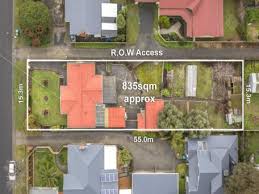7 Steps for knowing if your property has subdivision potential
Subdivision is one of the quickest ways to potentially make a profit through property.
When you subdivide a property, you need to get approval from the local council. They have their own regulations, which means dealing with different rules and individual challenges.
Here are 7 steps to narrow down your research and know if you may be able to subdivide:
1. Does your property have at least 800sqm in land size?
As local councils have their individual guidelines on the minimum land size required to subdivide, make sure you check with them first. In general, properties larger than 800sqm have potential.
2. Check that the property allows ample room for access.
Councils generally insist that there should be enough space between the edge of the house and boundary line to build a driveway. Therefore, you’re not just looking for a block that is big enough, but one that has adequate space for a driveway. This can range from 2.5m to 3.5m including landscaping.
3. Look for level or gently sloping land
As a rule of thumb, flat land is easier and cheaper to subdivide than a sloping block. That’s because a steep slope could restrict what you could build there. This would also factor in with the council’s minimum size requirement. They may, for example want a minimum land area of 300sqm per dwelling on a level block and/or a minimum of 400sqm if it’s a sloping block, to ensure the property has enough usable land. A sloping block could also require you to dig and build retaining walls which could eat into your profit.
4. Look for corner block properties
Corner blocks are good for subdivision and development as you could easily divide into two lots – each with its own street frontage and access. Bear in mind that if the block has kerb and guttering only on one side, the council can request you complete the kerb on both sides as a condition of the subdivision consent. Fifty metres of kerb and guttering can cost up to $30,000.
5. Check out the structure of the property
If you’re planning to subdivide within an existing dwelling, make sure that it’s well-built and has solid bones if you need to move it.
6. Understand the zoning rules
Check with the council that the property you’re about to buy complies with the zoning rules. If you’re planning to build medium density housing like a townhouse or duplex, ensure that the property is zoned for this structure.
Subdivision is one of the quickest ways to potentially make a profit through property. However, it has its risks and it’s highly complex. Make sure you do rigorous due diligence and gather as much information as possible. You may also want to consider seeking professional help to get your development application and project off the ground.
7. Consult with an agent familiar with subdivision.
A good local agent with expert knowledge of local property prices and buyer demand can assist you greatly in determining the benefits of a potential subdivision. They will also be able to refer you to a range of industry professionals and advise you on the potential benefits of subdivision.
Interested in exploring the potential to subdivide your property? Let us help you.

